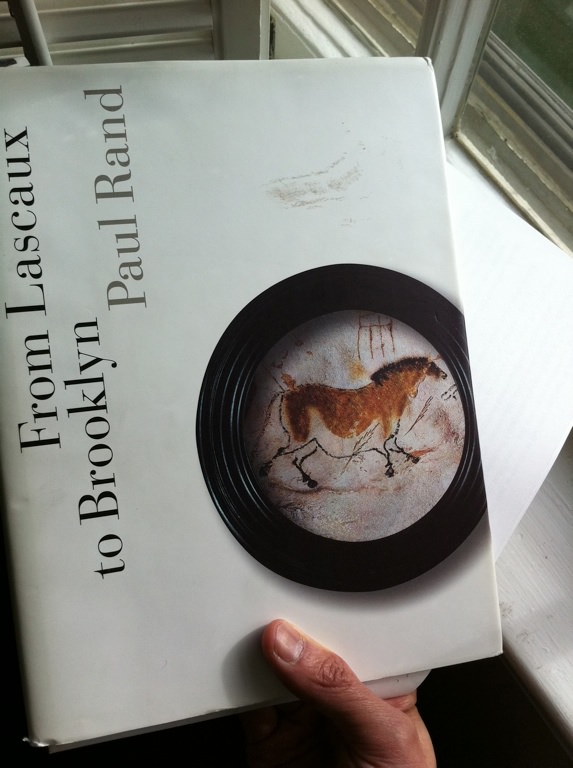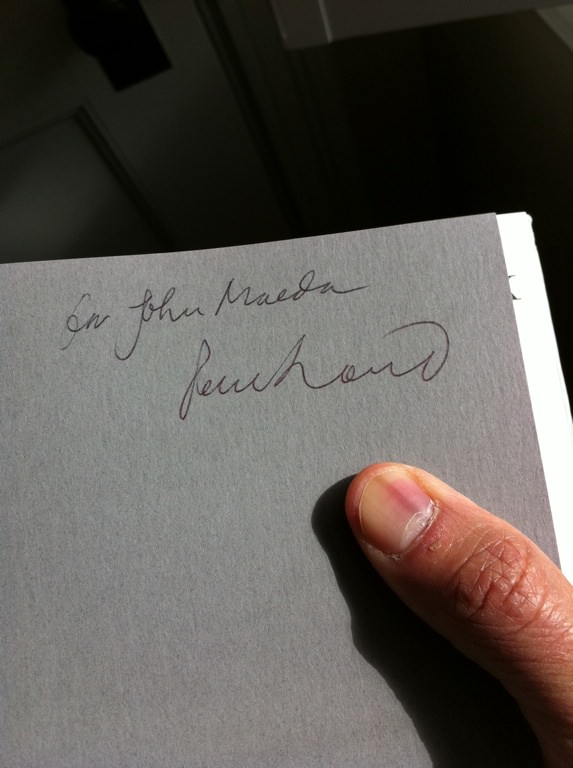The Language of Art, via Paul Rand
From 2011 ... | and from 2025, visit the new Design.Co

My introduction to the field of design came when I stumbled upon one of Paul Rand’s books while I was an undergrad at MIT. It was a little over a decade later when I had the fortune of meeting Mr. Rand at his studio in Connecticut in the mid 90s. He was alone, and that day his assistant hadn’t arrived yet. So he asked me to stay for the day and work on the final touches of his book. It was Mr. Rand’s last book, From Lascaux to Brooklyn. I can’t really explain the feeling of finding someone’s book, and then changing your entire life direction only to find yourself in a random moment years later typing your name into one of their books. It’s a good feeling, when you can get it. I visited Mr. Rand a year later and he gave me this copy of the book. He gave me a short essay that he wished was in the book that he had just handed out at his lecture at Cooper Union. Mr. Rand unfortunately died that year. He was 82 years old.

As I was looking at his book just yesterday -- I hadn’t touched it for years -- the two pages fell out and onto the floor. It’s Mr. Rand’s unpublished essay on “The Language of Art.” I looked for it on Google and it’s posted elsewhere, but I thought I’d post it here too. I enjoyed the essay immensely, and I hope you enjoy it too. He was quite controversial in his take on the relationship between content and form. Like all good artists and designers, he knew how to take a stance and stick to it with all his heart, body, and mind. Here are some notes from his last public lecture, which I hosted when I was a junior professor at MIT. -JM
The Language of Art
by Paul Rand
A miscellany of archeology, history, biography, geography, political science, psychology, sociology, technology, entertainment, economics, marketing, and merchandising comprises the subject matter of most art talk. But this does not constitute the language of art.
Art is primarily a question of form, not of content. This explains Clive Bell’s “significant form,” often maligned and misunderstood by practitioners, philosophers, dabblers, and connoisseurs. Content is a passive and subordinate yet important partner in this relationship, which is fundamental to an understanding of the language of plastic art.
To discuss the appearance of things is to deal with matters of aesthetics. Aesthetics is the language of appearances -- of art, design, the beautiful, and the ugly. Without aesthetics, talk about art is not about art. To talk about, study, teach, or criticize a work of art focus must always be on problems of form in relation, of course, to a particular content.
An artifact is transformed into a work of art only when the conflict between form and content is resolved. The term art, has been bandied about so carelessly that it has almost lost its meaning. For example, it seems that one of the ways a painting earns its place in the pantheon of art is by being rendered in a particular medium: oil on canvas. The so called lesser arts -- prints, etchings, graphic design, photography, etc. -- are confined to this status by virtue of the mechanical means of their making. Consequently, the medium in which a work is rendered can become as important as its message or meaning. Symbolism has become the measure of value. The recent auction of Jacqueline Onassis’ possessions is a prime example of the power of false values.
Form and content are assymetric. Formal values are very often independent of content. Time can, and does, erase meaning of once familiar artifacts, but time can never erase form. Spontaneity, fantasy, intuition, invention, and revelation also play an important part in the language of art.
Among the many aspects of form, problems pertaining to the principles of proportion, for example, are significant. The rules of proportion apply equally well to the Parthenon or to a can of Campbells soup. The same is true for all formal relationships: contrast, scale, balance, rhythm, rhyme, texture, repetition, etc.
In spite of the fact that aesthetics is the only language of art, the subject has been greeted with indifference and sometimes irreverence. For example, Gwilt’s Encyclopedia of Architecture (1842) describes aesthetics as “silly, pedantic term, and one of the useless additions to nomenclature in the arts.” These and other unflattering references have caused this subject to be brushed aside. On the other hand, such definitions as “aesthetics is the philosophy or theory of taste,” or “of the perception of the beautiful in nature and art” (Oxford English Dictionary) are too passive, to be really useful.
The Greeks considered all subjects a form of discourse, and therefore almost all education is a form of language education. Knowledge of a subject means knowledge of the language of that subject. Biology, after all, is not plants and animals, it is a special language employed to speak about plants and animals. Similarly aesthetics is not painting, design, or architecture; it is a special language designed to speak about these subjects, namely the language of interaction between form and content.
Confusion and misunderstanding is the result of the absence of a common language. In dealing with the subject of design, knowledge of the history of art and design is just as indispensable as the language of art. “Any subject,” said William James, “becomes humanistic when seen from the stand point of history.” Since both the history and language of art are not part of our common understanding, political, social and technological issues that may have only a remote connection to art arc usually substituted for discussions about the real thing -- aesthetics -- the language of art.
Copyright 2009 - 2025, John Maeda
